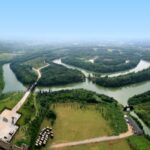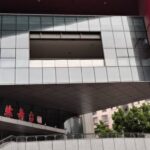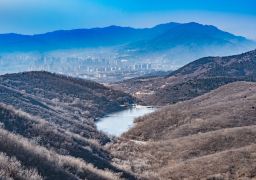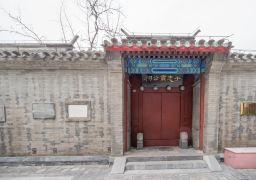Jiming Temple, also known as the Ancient Jiming Temple, stands as one of the oldest Buddhist temples in Nanjing, located to the north of Xuanwu Lake. Its history is rich and dates back to the Qi Xuan Temple of the Eastern Wu period, during the Three Kingdoms era, when the temple site was part of the rear garden of the Wu Kingdom. In 300 AD, during the first year of the Yongkang era of the Western Jin Dynasty, the temple was constructed against the mountain, establishing it as a place of worship.
During the Qingming Festival, visitors to Jiming Temple can delight in a sea of cherry blossoms along the road in front of the temple. In the summer, the Medicine Buddha Pagoda offers a picturesque view of the lotus flowers adorning Xuanwu Lake.
After the Eastern Jin Dynasty, the site was designated as the Tingwei Office. It wasn’t until 527 AD, in the eighth year of the common era of the Southern Dynasties’ Liang Dynasty, that Emperor Wu of Liang transformed the place into a true Buddhist sacred site by building at Jiming Dike. The temple was further developed in 1387 AD, during the twentieth year of the Hongwu era of the Ming Dynasty, when Emperor Zhu Yuanzhang ordered the old buildings to be demolished and the temple to be expanded and rebuilt. Zhu Yuanzhang inscribed the temple with the name ‘Jiming Temple’, and after expansions during the Ming Xuande, Chenghua, and Hongzhi years, the temple compound became grand.
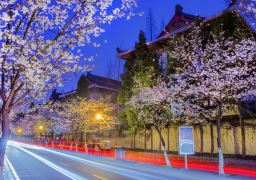
Tragically, the ancient temple was destroyed in the Xianfeng war. Although repairs were made during the Tongzhi period, the scale was greatly reduced. Despite these setbacks, the temple has always been a prosperous place of worship.Visiting Jiming Temple, one is greeted by its main gate, which is situated on the left side of Jiming Temple Road, atop stone steps. The gate is marked by the four golden characters ‘Ancient Jiming Temple’ at its center. Upon entering, the temple’s environment is a serene and elegant one, with intricate Buddhist halls and the lingering fragrance of incense. To the left of the entrance stands the alms platform, with the Maitreya Hall just in front of it. Above the Maitreya Hall, one can find the Mahavira Hall and the Guanyin Pavilion. The temple complex also includes other significant buildings such as the Wei Tuo Hall, Zhi Gong Tomb, Sutra Library, Nianfo Hall, and the Medicine Buddha Pagoda.
The Mahavira Hall, alternatively known as the Vairocana Hall, stands as the temple’s principal hall. Inside, the central figure is the Vairocana Buddha, representing the Dharma Body of Buddha, flanked by the two great Bodhisattvas, Manjushri and Samantabhadra. Additionally, the twenty-four heavenly kings are enshrined on the eastern and western sides of the hall.
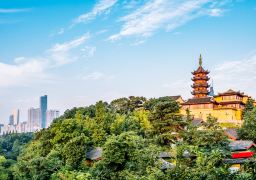
The Medicine Buddha Pagoda, with its seven levels and eight sides, houses a copper statue of the Medicine Buddha. Interestingly, this pagoda served as the backdrop for the Leifeng Pagoda in the TV drama ‘New Legend of the White Snake,’ as the original Leifeng Pagoda in West Lake had collapsed and the new one had not yet been reconstructed at the time of filming.
At Jiming Temple, visitors have the opportunity to draw lots and write wish cards, which they can hang up as a form of prayer. The temple sees a significant influx of tourists on the lunar calendar dates of February 19th, June 9th, and September 19th, which correspond to the birthdays, enlightenment, and monastic commemoration days of Guanyin Bodhisattva. These days are particularly auspicious for worship and the burning of incense.Worship at Jiming Temple takes place not in the main hall but on the large platform situated in front of the incense platform. A massive red candle stands at the forefront of the incense platform, accompanied by a row of lotus oil lamps on the outer platform for worshippers to burn incense. Additionally, columns of burning incense can be found on the inner platform.
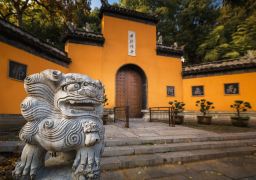
On the northeast side of the temple, you’ll find the Rouge Well, which is believed to have served as a hiding place for Emperor Chen Shubao of Chen, his consort Zhang Lihua, and Lady Kong during the Sui Dynasty’s destruction of Chen. This historical significance attracts many tourists to the site.
Jiming Temple is open to visitors all year round from 07:30 to 17:00. Here are some essential tips to keep in mind during your visit:
1. If the Medicine Buddha Pagoda is undergoing maintenance, it will not be possible to climb the pagoda. However, you can still view the Buddha statue on the first floor.
2. Don’t miss the opportunity to try the famous vegetarian noodles at Jiming Temple, which are priced at approximately 15 yuan per bowl.
For more information, you can follow the temple’s official WeChat account: nanjingjimingsi (Jiming Temple, Nanjing), or their official Weibo account: Jiming Temple, Nanjing.


